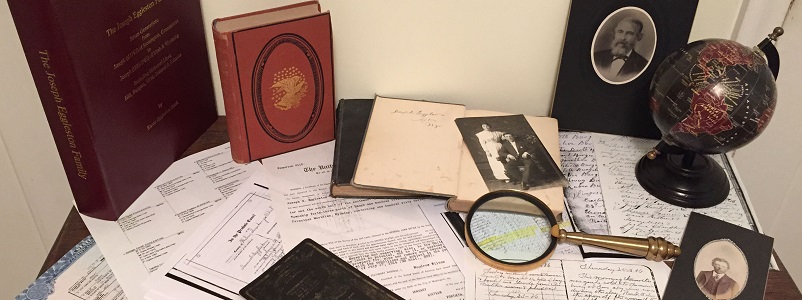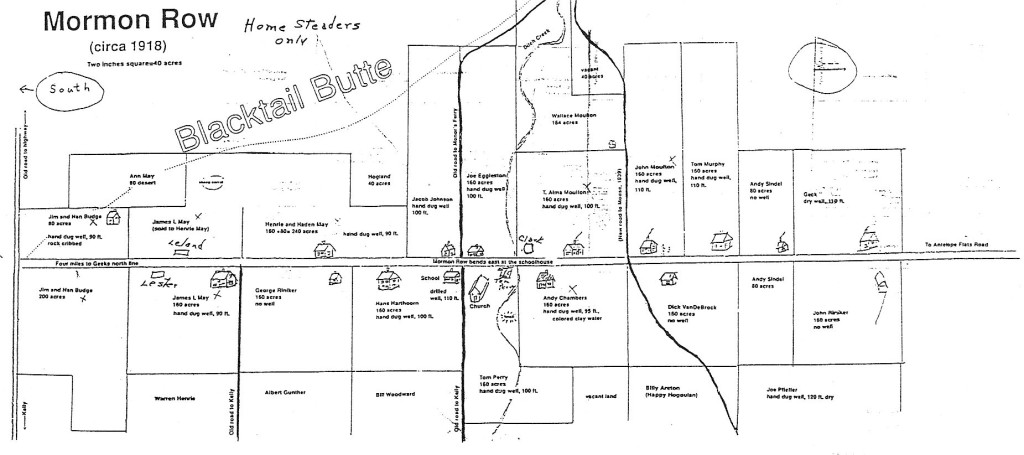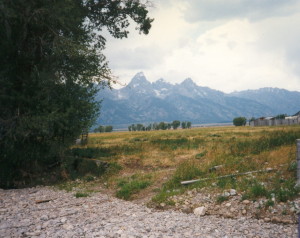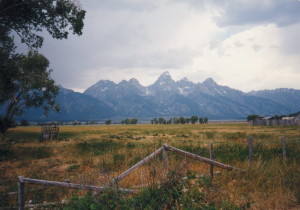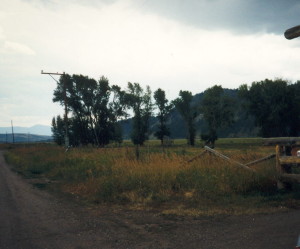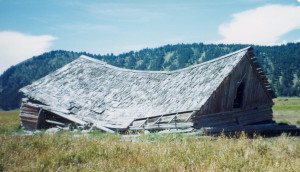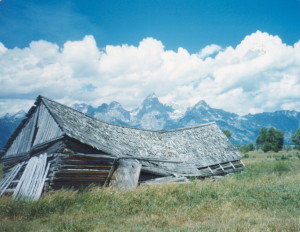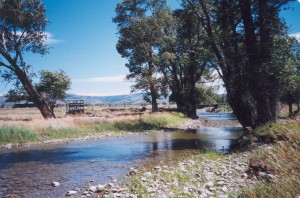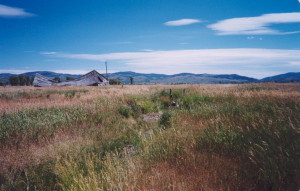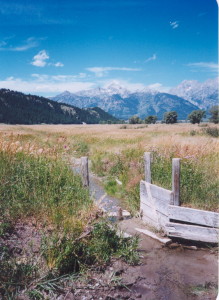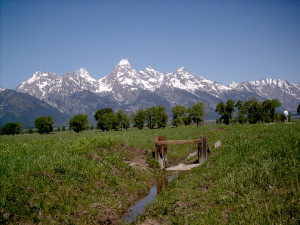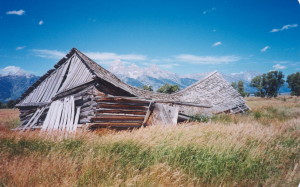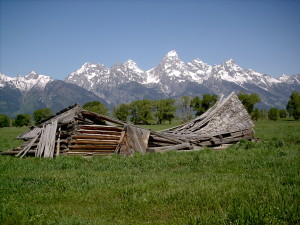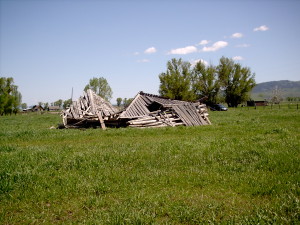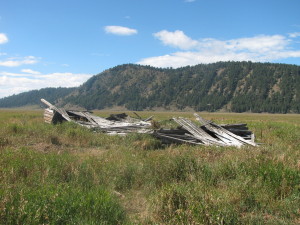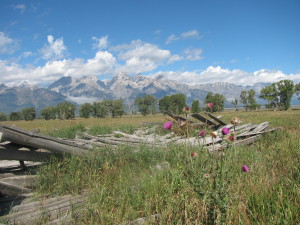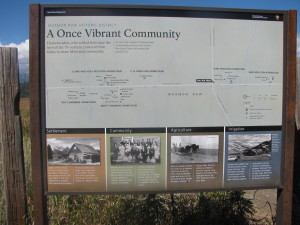I first became aware of the existence of Mormon Row in 1996. I had done genealogy research for some time and knew that Grandpa and Grandma Eggleston’s first four children were born in Grovont, Wyoming. I had no idea where Grovont was – I don’t think it is on any current maps – just somewhere in the Jackson Hole area. In 1996, my Dad was invited to a Mormon Row Centennial Celebration for descendants of the original homesteaders. The first homestead was granted in 1896. Eventually there were 21 homesteads there.
I was not able to go with Dad for the celebration, but he enjoyed getting to know the families and seeing the place. My family made a trip to Jackson Hole later that summer. With Dad’s directions we found Mormon Row. It was not hard to spot Moulton’s Cabin – the famous one in so many photographs with the Tetons in the background. We had been told that Grandpa’s homestead was just south of Moulton’s, but we could not tell where the property line was. We found Ditch Creek. The weather was threatening, but I walked around and took some photos.
We returned to Mormon Row in 1999, now knowing a little more about it because in 1998 Teton National Park had begun an assessment process to address preservation and interpretation options for the remaining structures there in what they had designated the Mormon Row Historic District. They printed a booklet with maps and photos identifying the various homesteads and structures and proposing several different options that were being considered.
Mormon Row History
James May began the first homestead in 1896. He had looked over the area in 1894, then in 1896 returned with his family and the Allen, Budge and McBride families. May and Budge filed on homesteads at the south end of Blacktail Butte and began what became known as “Mormon Row” because they and most of the following settlers were Mormon families. The Homestead Act of 1862 provided for 160 acre parcels of land, which was deeded after establishing a residence and farming for a number of years. Grandpa’s deed was granted on January 5, 1916, and signed by President Woodrow Wilson.
T. A. Moulton began constructing the now famous barn in 1913. Grandpa Joe Eggleston had the homestead to the south of Moulton on which were the remains of his homestead cabin – further south than I had wandered in my 1996 visit. Grandpa began constructing this cabin about 1910.
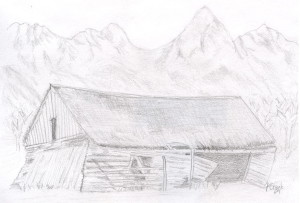
I made this drawing from an early photograph I found at the Jackson Hole Historical Society which was taken shortly before the cabin collapsed.
Joe came to Mormon Row with his uncle Jacob Johnson. Jake and his twin brother Ephraim had started a sawmill in nearby Wilson, Wyoming and Ephraim continued to run the sawmill and supplied Joe and Jake with lumber. Grandpa later built a two-story frame house, where he brought Grandma when they married in 1914. That house burned down in 1926 after they had returned to Utah and their place had been sold to Chambers.
Water for irrigation was more of a priority for a homestead than a house, so on June 13, 1910 Jacob and Joe “appropriated four cubic feet per second of water from Ditch Creek, sufficient to irrigate for 70-acre parcels.” Their ditch was known as the Johnson/Eggleston ditch and was one-foot deep, four feet wide at the bottom, and five feet wide at the top. It went from Ditch Creek along the west of Grandpa’s homestead and then turned east, running between his homestead and Jacob’s which was south of it, as can be seen on the map above. I saw photographed some of the remains of the ditch in 2002 and 2004.
The Deteriorating Cabin
On my 1999 visit I explored the collapsing cabin, then returned in 2002 and 2004 to further explore the ditch and document the decline of the cabin. The National Park Service eventually decided to do limited restoration of some of the Mormon Row buildings, but it was decided to let Grandpa’s cabin continue to deteriorate until it is now pretty much a pile of wood.
On my 2013 visit we saw interpretive signs, mostly around the other Moulton homestead at the north end of Mormon Row.
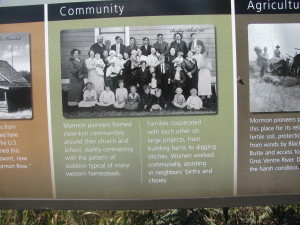
Sunday School group photo. Grandma is standing on the left holding a baby. Grandpa is in the back middle.
Life on Mormon Row was hard for the Egglestons and their stay there was fairly brief. They were involved with the little Branch of the Church of Jesus Christ of Latter-day Saints and the Church building was across the street from their home. Grandpa Joe served as Sunday School President and Grandma Cuma was Relief Society President and played the organ in Church. They had the Post Office in their home for a time. Grandpa had carried mail over Teton Pass years earlier. It was when this little community applied for a Post Office that the name Grovont was given to it. It was an Americanization of the name of the nearby Gros Venture River. Alice remembered helping her mother in the Post Office. She also had fond memories of some of the people there. Winters were very harsh. Alice remembered the snow reaching the second story window and her father shoveling a trench to get to the barn. Elk from the nearby refuge helped themselves to the hay.
In 1919, Grandpa sold his homestead to a neighbor and returned to Eden, Utah where he had been born. When Teton National Park was created, Mormon Row was within the boundaries of the Park. The government bought out all of the residents, except for Clark Moulton who refused to sell one acre of land where their home and barn still stand.
